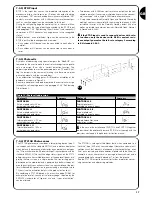
4
RUN is a range of irreversible electromechanical gearmotors used for
the automation of sliding gates. They are equipped with an electron-
ic control unit and an “SM” type connector for radio control receivers
(optional ). Electrical connections to external devices are facilitated
thanks to the use of the “BlueBUS” system, which enables the con-
nection of several devices by means of just 2 wires. The list of
devices compatible for connection to the Run BlueBUS is given in
chapter 7.3.1 "BlueBUS"; an updated list, with relative compatibility
is also available at: www.niceforyou.com. RUN is equipped with a
connector for remote programming units to enable complete and
quick management of installation, maintenance, troubleshooting of
any malfunctions; refer also to 7.8.1 "Remote programming unit".
RUN is electrically powered, in the event of a power failure, the
device can be released by means of the special key, to enable man-
ual movement of the gate.
Other products are also part of the RUN range, the difference of which is described in table 1.
Note: 1Kg = 9,81N for example: 1390N = 142 Kg
2) Product description and applications
1
Gearmotor type
RUN1800
RUN1800P
RUN2500
RUN2500P
Limit switch type
electromechanical
inductive proximity
electromechanical
inductive proximity
Maximum leaf length
15m
Maximum leaf weight
1800Kg
Peak thrust
50Nm
(corresponding to a force)
(1390N)
Motor
Single phase asynchronous maximum 700W
Table 1: comparison of the RUN gearmotor main characteristics
2.1) Operating limits
Chapter 8 “Technical Characteristics” provides the only data needed
to determine whether the products of the RUN line are suitable for
the intended application. The structural characteristics of RUN make
it suitable for use on sliding leaves in conformity with the limits spec-
ified in tables 2, 3 and 4.
The effective suitability of RUN to automate a sliding gate depends
on friction and other factors, even occasional, such as the presence
of ice which could obstruct leaf movement. To ensure suitability, it is
absolutely vital to measure the force necessary to move the leaf
throughout its entire run and ensure that this is less than half of the
“nominal torque” indicated in chapter 8 “Technical characteristics” (a
50% margin on the force is recommended, as unfavourable climatic
conditions may cause an increase in the friction); furthermore, the
data specified in tables 2 and 3 should be taken into account to
establish the number of cycles/hour and consecutive cycles.
RUN1800/ RUN1800P
RUN2500/ RUN2500P
Leaf width(m)
max. cycles/hour
max. consecutive cycles
max. cycles/hour
max. consecutive cycles
Up to 6
55
50
6 ÷ 9
36
32
9 ÷ 12
27
24
12 ÷ 15
22
20
15 ÷ 18
Table 2: limits in relation to the length of the leaf
400mm
253mm
387mm
108mm





































